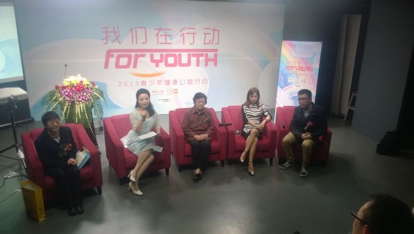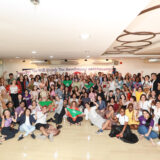Young China Needs More Information About Pregnancy and Abortion
Recent ASAP Youth Champion Yu Yang took part in an online youth forum. Here he writes about his experience.
On Nov. 1, I took part in an online forum, named “For Youth, We are taking action”, discussing about the young girls’ pregnancy issues in China with professors, doctors and bestselling author. You could see the details using this link, but unfortunately, it doesn’t have an English version. So, I would like to write something about this activity and youth pregnancy and abortion issues in China.
 According to the 2013 State of World Population Report, or 2013 SWOP, released by UNFPA, motherhood in childhood is a huge global problem, especially in developing countries, where every year, 7.3 million girls under 18 give birth. Arie Hoekman, the director of UNFPA China pointed out at the youth forum that unwanted pregnancy and high abortion rate among Chinese young girls are strong indicators of the lack of access to comprehensive sexual education.
According to the 2013 State of World Population Report, or 2013 SWOP, released by UNFPA, motherhood in childhood is a huge global problem, especially in developing countries, where every year, 7.3 million girls under 18 give birth. Arie Hoekman, the director of UNFPA China pointed out at the youth forum that unwanted pregnancy and high abortion rate among Chinese young girls are strong indicators of the lack of access to comprehensive sexual education.
Then, Zhang Lei from the Population Research Institute of Beijing University presented some key findings on adolescent pregnancy in China from the first UNFPA-supported national survey on access and utilization of sexual and reproductive health services by unmarried youth ages 15 to 24. The research showed that, even though the majority of unmarried youth are open to having sex before marriage, only a very small portion of them—less than five percent, are well informed about reproductive health. Less than 15 percent had correct knowledge about preventing HIV infection. The survey showed that four out of 100 unmarried girls ages 15-24 have been pregnant, and almost 90 percent of these pregnancies resulted in an abortion.
The data was collected from 2009-2010 and includes a nationwide, representative survey with 22,235 questionnaires collected from unmarried youth aged 15-24 years old and a number of in-depth interviews and focus group discussion with youth, health practitioners, teachers, government officials and other key stakeholders. I asked Zhang Lei for the full text of the report and am sharing the highlights on pregnancy and abortion:
Pregnancy
- Among females who had been sexually active, 21.4% (17.0% aged 15-19 years old and 22.8% aged 20-24 years old) has experienced unplanned pregnancies of which 5.0% (5.9/4.8%) have experienced repeat pregnancies.
- Almost the same proportion (19.3%) of men report that they have caused pregnancies.
- Youth pregnancy rate is 41.1 per 1,000 women aged 15-24 years old, 13.6 per 1,000 women aged 15-19 years old and 78.3 per 1,000 women aged 20-24 years.
- Association between specific risk behaviours (age at first sex, number of partners, one night stands, no contraceptive use at last sex) and outcomes (pregnancy)
Pregnancy Outcome
- Youth abortion rate is 37.1 per 1,000 women aged 15-24 years old, 12.2 per 1,000 women aged 15-19 years old and 71.0 per 1,000 women aged 20-24 years old.
- Among female youth who has been pregnant 88.6% resort to abortion and 18.8% have had more than one abortion. The proportion of female youth who have experienced repeat abortions is higher among those aged 15-19 years old than among women aged 20-24 years old.
- Of the pregnancies that are not terminated with induced abortion, 4.7% of the women were still pregnant at the time of survey, 6.0% had experienced a miscarriage, 0.3% of pregnancies result in still births and 0.4% in live birth. 2.1% of female youth aged 15-19 years old and 0.0% for female youth aged 20-24 years old have experienced live births.
- This indicates a youth fertility rate of 0.164 per 1,000 women aged 15-24 years old, 0.286 per 1,000 women aged 15-19 years old and 0.0 per 1,000 women aged 20-24 years old.
The high pregnancy and abortion rates amongst sexually active youth and especially the high proportion of repeat abortions can be seen as a result of the low level of knowledge of sexual and reproductive health, contraception and HIV/AIDS, which is associated with a low risk perception of HIV, STIs, pregnancy, and abortion and low contraceptive use.
Pregnancy and abortion are major life events that are likely to cause some long lasting physical and psycho-social reactions for the women, who experienced them. This is especially true for the relatively mentally immature group of younger youth aged 15-19, who do not always possess the understanding, skills or support to deal with clinical and social consequences. Meanwhile, from the survey results it is evident that although the majority of youth consider abortion as a challenge, these considerations seem to play a limited role when dealing with the negative outcomes of unsafe sex. This implies that a ‘normalization’ process of such procedures is taking place, where abortion is considered as more of method of post-coitus contraception amongst unmarried youth in China.
 Coming back to the forum, I introduced myself as core member of China Youth Network and youth champion of ASAP. I said that it was ASAP that gave me the chance to learn about the abortion issues of China in a worldwide frame. Compared with other countries, where abortion is illegal or highly restricted, China did legalize abortion long time ago and there do have a lot of service providers all over the country. Though it sounds great, we are still facing lots of serious challenges, which we discussed about during the forum.
Coming back to the forum, I introduced myself as core member of China Youth Network and youth champion of ASAP. I said that it was ASAP that gave me the chance to learn about the abortion issues of China in a worldwide frame. Compared with other countries, where abortion is illegal or highly restricted, China did legalize abortion long time ago and there do have a lot of service providers all over the country. Though it sounds great, we are still facing lots of serious challenges, which we discussed about during the forum.
Here are the following:
- The “normalization” of abortion as a method of contraception causes high rate of repeat abortions. These may not always however be safe, even though abortion is legal and available in China. Additionally, Chinese youth don’t have the awareness of injuries of repeat unsafe abortion and what constitutes a safe abortion.
- At the school level, most students from remote places, rather than Beijing and Shanghai, never had in-depth sex education at all. The knowledge they acquire before they come to the university is too superficial; it does little to help them protect themselves, which results in a high rate of unwanted pregnancy.
- The Chinese government provide the very cheap (even free) abortion service for women. However, they didn’t take young girls into consideration. All the related policies were carried out only for married women, which means that young girls could hardly get cheap or free abortion service from them.
So the forum advocated for the need for strengthened information and education about contraception, pregnancy and abortion as well increased availability of quality reproductive healthcare services that understand the specific needs of unmarried youth and, in particular, their needs for contraceptive and post-abortion counseling, which could decrease the prevalence of repeat abortions.
Besides, we also asked for the government to enact more youth friendly policies for young people to break down all the barriers to get the comprehensive sexual education and safe abortion service.






